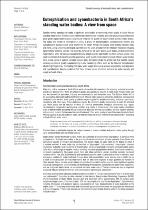 ResearchSpace
ResearchSpace
Eutrophication and cyanobacteria in South Africa’s standing water bodies: A view from space
JavaScript is disabled for your browser. Some features of this site may not work without it.
- ResearchSpace
- →
- Research Publications/Outputs
- →
- Journal Articles
- →
- View Item
| dc.contributor.author |
Matthews, MW

|
|
| dc.contributor.author |
Bernard, Stewart

|
|
| dc.date.accessioned | 2016-05-16T10:17:51Z | |
| dc.date.available | 2016-05-16T10:17:51Z | |
| dc.date.issued | 2015-05 | |
| dc.identifier.citation | Matthews, M.W. and Bernard, S. 2015. Eutrophication and cyanobacteria in South Africa’s standing water bodies: A view from space. In: South African Journal of Science, 111(5/6), pp 1-8 | en_US |
| dc.identifier.issn | 0038-2353 | |
| dc.identifier.uri | http://www.sajs.co.za/eutrophication-and-cyanobacteria-south-africa%E2%80%99s-standing-water-bodies-view-space/mark-w-matthews-stewart-bernard | |
| dc.identifier.uri | http://hdl.handle.net/10204/8543 | |
| dc.description | Copyright: 2015 AASAF | en_US |
| dc.description.abstract | Satellite remote sensing can make a significant contribution to monitoring water quality in South African standing water bodies. Eutrophication, defined as enrichment by nutrients, and toxin-producing cyanobacteria (blue-green algae) blooms pose a significant threat to the quality of South African surface water bodies. The status and trends of chlorophyll a (chl-a, a proxy for eutrophication), cyanobacterial blooms and cyanobacterial surface scum were determined for South Africa’s 50 largest water bodies between 2002 and 2012, using a recently developed algorithm and 10 years of data from the Medium Resolution Imaging Spectrometer (MERIS) satellite. The majority (62%) of the 50 water bodies were highly nutrient enriched or hypertrophic, while 26 had cyanobacterial blooms which posed a high health risk from surface scums. This study is the first of its kind to provide quantitative water quality information for South Africa’s water bodies from a time series of satellite remotely sensed data. We demonstrate the pivotal role that satellite remote sensing can play in greatly supplementing in-situ monitoring efforts such as the National Eutrophication Monitoring Programme. The finding that many water supply bodies are severely impacted by eutrophication and cyanobacterial blooms confirms that these remain issues of critical concern for water security and supply in South Africa. | en_US |
| dc.language.iso | en | en_US |
| dc.publisher | ASSAF | en_US |
| dc.relation.ispartofseries | Workflow;15934 | |
| dc.subject | Water quality | en_US |
| dc.subject | Remote sensing | en_US |
| dc.subject | MERIS satellite | en_US |
| dc.subject | Turbidity | en_US |
| dc.title | Eutrophication and cyanobacteria in South Africa’s standing water bodies: A view from space | en_US |
| dc.type | Article | en_US |
| dc.identifier.apacitation | Matthews, M., & Bernard, S. (2015). Eutrophication and cyanobacteria in South Africa’s standing water bodies: A view from space. http://hdl.handle.net/10204/8543 | en_ZA |
| dc.identifier.chicagocitation | Matthews, MW, and Stewart Bernard "Eutrophication and cyanobacteria in South Africa’s standing water bodies: A view from space." (2015) http://hdl.handle.net/10204/8543 | en_ZA |
| dc.identifier.vancouvercitation | Matthews M, Bernard S. Eutrophication and cyanobacteria in South Africa’s standing water bodies: A view from space. 2015; http://hdl.handle.net/10204/8543. | en_ZA |
| dc.identifier.ris | TY - Article AU - Matthews, MW AU - Bernard, Stewart AB - Satellite remote sensing can make a significant contribution to monitoring water quality in South African standing water bodies. Eutrophication, defined as enrichment by nutrients, and toxin-producing cyanobacteria (blue-green algae) blooms pose a significant threat to the quality of South African surface water bodies. The status and trends of chlorophyll a (chl-a, a proxy for eutrophication), cyanobacterial blooms and cyanobacterial surface scum were determined for South Africa’s 50 largest water bodies between 2002 and 2012, using a recently developed algorithm and 10 years of data from the Medium Resolution Imaging Spectrometer (MERIS) satellite. The majority (62%) of the 50 water bodies were highly nutrient enriched or hypertrophic, while 26 had cyanobacterial blooms which posed a high health risk from surface scums. This study is the first of its kind to provide quantitative water quality information for South Africa’s water bodies from a time series of satellite remotely sensed data. We demonstrate the pivotal role that satellite remote sensing can play in greatly supplementing in-situ monitoring efforts such as the National Eutrophication Monitoring Programme. The finding that many water supply bodies are severely impacted by eutrophication and cyanobacterial blooms confirms that these remain issues of critical concern for water security and supply in South Africa. DA - 2015-05 DB - ResearchSpace DP - CSIR KW - Water quality KW - Remote sensing KW - MERIS satellite KW - Turbidity LK - https://researchspace.csir.co.za PY - 2015 SM - 0038-2353 T1 - Eutrophication and cyanobacteria in South Africa’s standing water bodies: A view from space TI - Eutrophication and cyanobacteria in South Africa’s standing water bodies: A view from space UR - http://hdl.handle.net/10204/8543 ER - | en_ZA |





